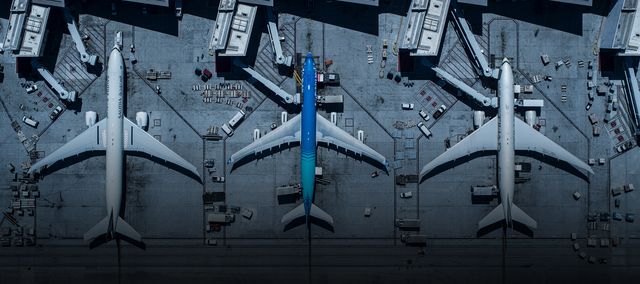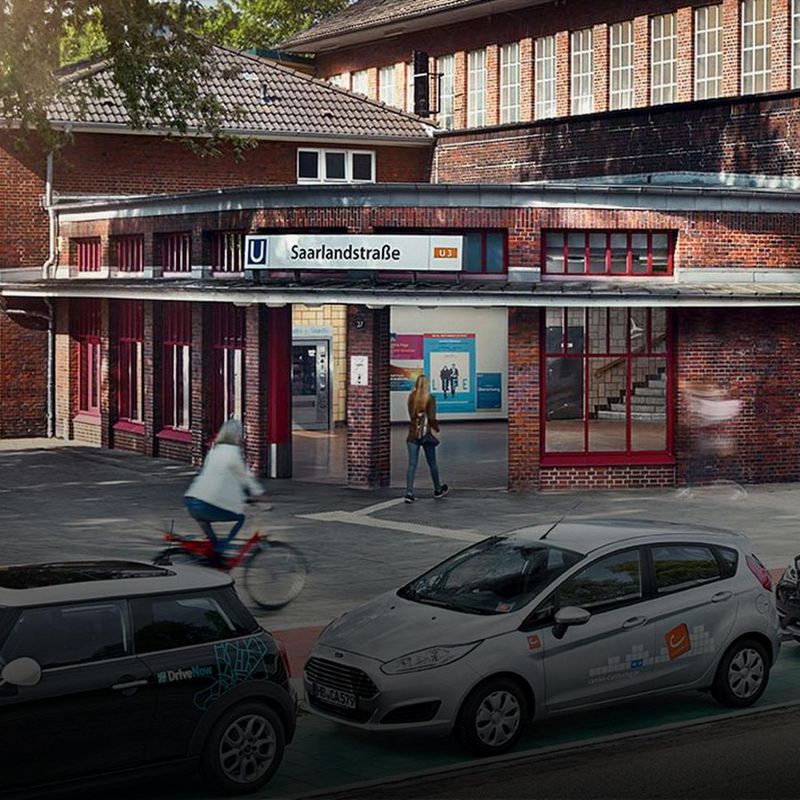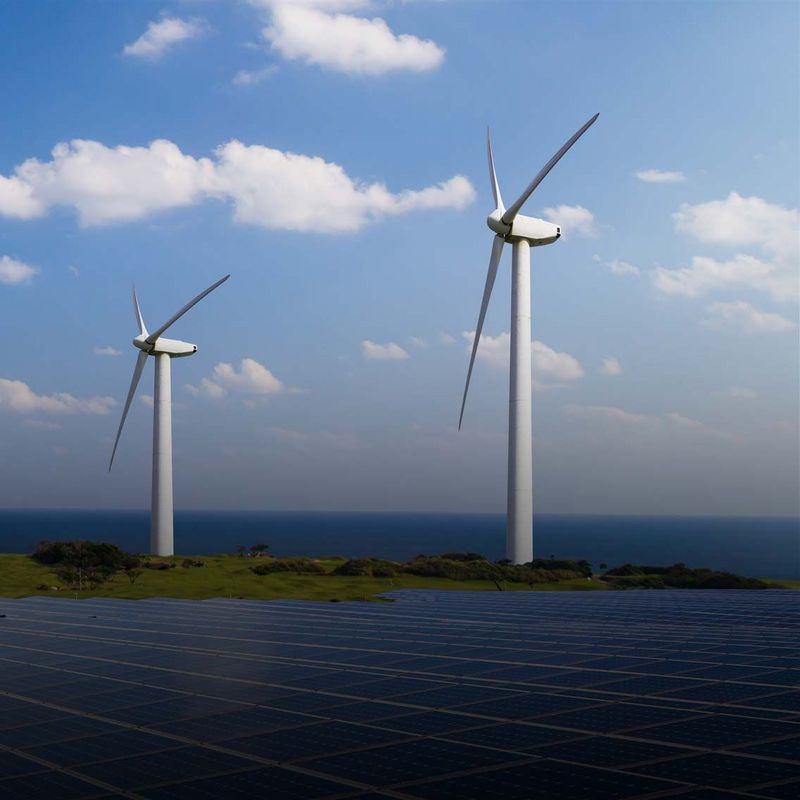12 December 2019
For everything from holidays in New Zealand to weekend breaks in Lisbon, thanks to the rise of the discount airlines, air travel, formerly the preserve of the better off, has long since become a means of transport for the masses. And its impact on the climate is rising with passenger numbers. The hope is now that batteries, hydrogen and alternative fuels will clean up flying.
There’s no end in sight to the stellar growth of aviation. Since 2009, global passenger numbers have risen from around 2.5 billion to 3.3 billion, and air traffic has increased by almost five percent annually – with far-reaching environmental consequences. Air travel currently generates 2.5 percent of global CO2 emissions. At first glance, that doesn’t seem a lot. But since the exhaust gases are emitted at high altitude, where there is nothing to mitigate their harmful effect on the environment, climate researchers put the real figure at anything from 5 to 7.5 percent. The sector has now finally woken up to the reality that air travel simply has to clean up its act and is also being confronted with more stringent limits and flight-shaming debates. The European aviation sector aims to reduce its emissions to 50 percent of the 2005 values by 2050. If this goal is to be achieved, all the experts agree that one single measure will not be enough.
One possible alternative for short-haul flights with few passengers would be electric planes. However, for longer distances or the transport of cargo, their batteries would be too big and heavy. The German Aerospace Center (DLR) calculates that more than 50 tonnes of batteries would be required to electrify, for instance, a modern passenger plane such as the 200-seater Airbus A320 - and, according to the DLR’s experts, even that would be sufficient for no more than 20 minutes of flying time. Smaller electric aircraft with up to ten seats for regional use are, on the other hand, being developed all over the world. The management consultancy Roland Berger currently counts 200 projects being run by aircraft manufacturers, airlines and start-ups.
Researching the next generation of batteries
In the medium term, Jens Friedrichs predicts that the next generation of batteries should make electric flight possible on a larger scale. Friedrichs heads the Institute of Jet Propulsion and Turbomachinery and is also the spokesman for the Excellence Cluster for Sustainable and Energy-Efficient Aviation at the Technical University of Braunschweig. Batteries based, for instance, on lithium and sulphur could be produced in a more environmentally sound way and to be less flammable and, at the same time, deliver three times as much energy as the current crop of lithium-ion batteries. In theory, at least: if their potential is to be unlocked for mass production, a whole raft of technical issues must first be solved. For example, today's lithium-sulphur battery prototypes are significantly less durable than modern batteries. “Erring on the conservative side, we assume that the next generation of batteries won’t be commercially viable until 2035 or 2040,” Friedrichs says. With these batteries, it would be possible to carry a maximum of 600 passengers a distance of up to 600 kilometres in an electric aircraft. However, it isn’t enough simply to install new engines and batteries in old aircraft models. “As is the case with today’s electric vehicles, we’re going to have to design every aircraft around the propulsion system to be installed in it if we’re going to achieve the highest levels of efficiency and the greatest possible range,” the engineer emphasises. The declared aim is this: to use lighter materials and improved aerodynamics to reduce the energy needs of these and other aircraft by 40 to 50 percent in the medium term.
“We need to reduce short-haul flights as much as we can. But because we can’t completely replace them with rail, we need solutions like electric planes.”
The benefit of electric aircraft is this: when fuelled with electricity from wind, solar or hydropower, they don’t discharge any emissions into the atmosphere when in flight. Unlike classic aircraft, they also don’t cause any indirect damage to the climate by releasing nitrogen oxides, ozone or soot or by forming vapour trails or clouds at an altitude of 10,000 metres. One significant step forward in comparison to current systems is this: “From an environmental point of view, it isn’t a good idea to fly 700 kilometres or fewer in today’s aircraft,” Friedrichs explains. This is because, especially during take-off and landing, planes are particularly energy-intensive and release above-average emissions. “We need to reduce short-haul flights as much as we can. But because we can’t completely replace them with rail, we need solutions like electric planes.”
Taking to the skies with hydrogen
Fuel-cell-powered aircraft might also be able to take to the skies for short and medium distances. Hydrogen is converted in the fuel cell into the electric energy needed to drive electric motors. Since hydrogen can store significantly more energy per kilogramme than the current generation of batteries, it opens up the possibility of longer ranges. And if it’s produced using electricity from renewable sources, the jet engines will emit nothing other than water vapour. If the researchers from the DLR in Stuttgart have their way, hydrogen-powered planes will in 15 years or so be able to transport up to 80 passengers at speeds of between 550 and 600 kilometres per hour over distances of up to 2,000 kilometres in scheduled services. Californian firm ZeroAvia intends to equip aircraft for a maximum of 20 passengers and routes of up to 800 kilometres with fuel-cell propulsion systems, starting in 2022. One of the technical challenges is to ensure that the fuel cells work as reliably at high altitudes, where the air is thin and oxygen levels are low, as they do at ground level and at all other altitudes - problems with which car makers are not confronted on the ground. For Jens Friedrichs, a hydrogen propulsion system would be preferable, even for long-haul flights such as Munich to Hong Kong. “Mind you, we’d need different aircraft,” the aviation expert says. This is because one kilogramme of liquid hydrogen contains almost three times as much energy as the equivalent amount of kerosene. But liquid hydrogen takes up significantly more space, which means noticeably bigger tanks. And it would no longer be possible to accommodate them in the aircraft’s wings.
Innovative aircraft concepts for improved efficiency
For Friedrichs, a promising solution to this issue comes in the form of the blended wing-body aircraft. Unlike today’s construction method, which involves fitting wings to a tube, the flatfish-like rear end of this type of aircraft blends seamlessly into the wings, thereby also contributing to the lift. “This kind of aircraft construction is very aerodynamic and offers a great deal of space for passengers, cargo and, of course, hydrogen,” the engineer explains. Boeing and NASA tested just such a plane back in 2012 and 2013. The tests proved that the plane could be steered just like a conventional aircraft while making less noise and using less fuel.
With the support of Dutch carrier KLM, the Technical University of Delft is currently working on a smaller prototype of a blended wing-body aircraft. When fully scaled up, the Flying-V model will be able to seat over 300 passengers, as many as the European long-haul plane, the A350, but with a reduction in kerosene use of some 20 percent. And yet, developments in the aviation sector are both expensive and extremely protracted affairs. For such aircraft to be designed, approved and built and also to be able take off from airports with tanks full of hydrogen will take decades.
© Henri Werij/FlyingVThe Flying-V prototype from Technical University of Delft Delft and KLM
New kerosene in old planes?
In the shorter term, alternative fuels may help mitigate the effects of long-haul flights: biokerosene made, for instance, out of rapeseed oil, algae and waste, or synthetic fuel produced using renewable electricity with no CO2 emissions. This alternative fuel is considered the most attractive by the airlines. No wonder - this “drop-in” solution could simply replace or be blended with conventional kerosene. Meaning that the existing planes and fuelling infrastructure could continue to be used. Passengers flying with airlines such as SAS, KLM or Lufthansa can already order the use of biokerosene as part of the fuel blend - albeit for an extra charge. This is supplied to Oslo airport by Finnish company Neste. The world’s biggest maker of biokerosene currently produces 100,000 tonnes per annum. Where the product differs from the first-generation biokerosene is that it uses little or no rape, corn, palm oil or other food crops. 80 percent of the biokerosene is instead made of waste and residual materials. When used in flying aircraft, it promises to reduce CO2 emissions by up to 80 percent in comparison to normal kerosene.
At the moment, however, it’s about three times more expensive. The intention is for larger production facilities to reduce the price to twice that of conventional kerosene. Neste is planning to build a refinery in Singapore with a capacity of one million tonnes per annum. And yet, this would be a mere drop in the ocean of the nearly 300 tonnes of kerosene burned each year by aircraft around the world. Although it will be possible to boost production capacities relatively quickly, this increase will be limited. This is because the available quantity of oil residues and plant waste is limited, and it isn’t yet possible to produce biokerosene viably from straw and wood. Although algae, another alternative on which much hope has been pinned, doesn’t need land, huge areas will be required for cultivation and further research if its potential as a source of fuel is going to be realised. It’s for this reason that, as aviation expert Jens Friedrichs sees it, biofuel is going to play an important role, especially as a bridging fuel which can quickly be made available: “When added to conventional kerosene in a ratio of 10 to 20 percent, it offers a quick way to reduce at least some of the CO2 emissions from existing aircraft until such time as new planes can be designed, approved and built.”
Ecopower + water + CO2 = Synfuels
The second great white hope for environmentally sound refuelling is still yet to take any more than baby steps but is generally viewed as the more promising candidate for the long term: synthetic kerosene, which can be produced in a variety of different ways. In the case of the Power-to-Liquid method, or PtL for short, hydrogen is extracted from water using electrolysis powered by renewable energy. Atmospheric CO2 is then added to produce synthetic oil which can in turn be processed into artificial kerosene. When an aircraft turbine burns this fuel, the previously fixed CO2 is released once again - and because it was taken out of the air in the first place instead of coming from crude oil extracted from the ground, the atmosphere is not further burdened by additional carbon dioxide. This artificial CO2 is thus carbon neutral. To date, however, such “synfuels” have only been produced on a small scale in pilot plants, for instance by Dresden-based Sunfire, which has been working on the method for a good ten years. The idea is for the co-electrolysis module of the Saxony-based firm to be used in the future in the Nordic Blue Crude project. Cleantech is planning the first major plant in the Herøya industrial park in Norway. From the end of 2021, the initial aim is to produce ten million litres - 8,000 tonnes - of synthetic mineral oil here. Once it has the experience from the first development phase under its belt, Nordic Blue Crude intends to increase its production capacities tenfold. In the long term, ten identical plants are planned in Scandinavia.
© sunfire GmbH, Dresden / renedeutscher.de / CC BY-ND 2.0*A Power-to-Liquid-Aappliance
In price terms, the synthetic fuel is even more expensive than the kerosene made from biomass. Nordic Blue Crude has estimated a price of less than two Euro for the synthetic mineral oil substitute. Crude oil, on the other hand, is currently trading at about 36 cents per litre.
A quantum solution for alternative fuel?
In order to kickstart the market for synthetic kerosene in Germany, the sector association Aireg, whose members include oil companies such as BP, aircraft manufacturer Airbus and various research institutes alongside synfuels producers like Sunfire, is calling for a quota for sustainable fuel alongside a state-funded pilot plant and subsidies. The scheme would mean that, as of 2021, airlines in Germany would have to add two percent of either biokerosene or synthetic kerosene to their fuel blend, with the proportion rising to 30 percent from 2030. In Norway, a quota of this kind has already been set out in law: As of January 2020, every passenger jet will be required by law to fill up with alternative kerosene - if initially only as an additive to the blend of a mere half of one percent. In ten years, this share will increase to 30 percent. Neighbouring Sweden is pursuing similar plans.
With increasing demand and higher production, the prices for synthetic kerosene ought to fall. The appetite for power of synthetic fuel is currently huge. If you were to refuel all the planes which take off in this country with synfuels, you would need all the energy produced from wind, sun and water in Germany to meet the demand - such, at least, was the calculation of Jakob Graichen from Öko-Institut e.V on German national radio. For Jens Friedrichs from the TU in Braunschweig, too, synfuels make sense but are in principle the costliest fuel in terms of both price and energy requirement. “Every kilowatt hour of power you generate flows through the battery, as it were directly into the propulsion system. To make liquid hydrogen you need more than twice the energy and twice the amount to make synthetic kerosene from it,” the aviation expert explains. What’s more, the method is only 100-percent carbon neutral on paper. “If the carbon dioxide from artificial kerosene is released at an altitude of 12,000 metres, it’ll have a different impact on the climate than it would here on the ground where it was previously fixed,” Friedrichs notes. “Which is why we should really only use synthetic fuels if there’s no other choice; otherwise we should rely on batteries and hydrogen.”
“If the carbon dioxide from artificial kerosene is released at an altitude of 12,000 metres, it’ll have a different impact on the climate than it would here on the ground where it was previously fixed.”
Because the optimum solution which takes all the factors into account is still some way over the horizon, the route that must be taken is obvious to Friedrichs: “We need to pursue all the approaches and energy routes with the same degree of intensity. We need political support to create a hydrogen infrastructure on the ground. After all, alongside fuel cells, we need this as a precursor to synthetic fuel,” the expert claims. Aviation is going to have to bid farewell to the standardisation of recent decades which it loves so dearly and turn instead to optimised aircraft with different propulsion systems for different distances and purposes. It’s true that there would be nothing to prevent individual countries from pressing ahead with setting the technological and political course at national level. However, there would be no getting around the need for international agreements to prevent national carriers subject to more stringent environmental regulations from falling behind the competition and to ensure that aircraft would find the fuelling and charging infrastructure they needed wherever in the world they might land. “Global aviation needs global solutions - and it’s these that we’re currently researching.”
ABOUT
© Kristina Rottig/TU Braunschweig
Jens Friedrichs heads the Institute of Jet Propulsion and Turbomachinery (IFAS) at the Technical University of Braunschweig. In the “Sustainable and Energy Effficient” Excellence cluster, the engineer has joined forces with an interdisciplinary team of scientists and universities to research into how sustainable and environmentally friendly aviation can be achieved.





